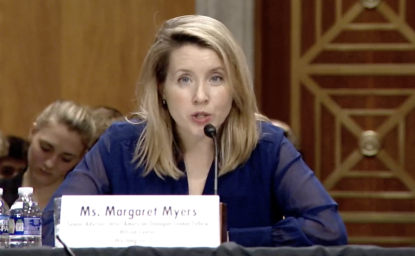China's 27 years of booming economic growth have brought millions out of poverty and turned the county into the world's factory. However, much of this economic success has been built on a foundation of ecological destruction, leaving China with smoggy cities, black rivers, growing desertification, and degraded coastal waters. Today's environmental problems seriously threaten China's economy, human health, and social stability.
Driving China's pollution problems are its dependence on coal for energy and a weak environmental governance system-—clearly illustrated by the poorly funded State Environmental Protection Administration. Further hampering environmental governance is local government protectionism and the still-limited, albeit improving, empowerment of public and civil society groups.
For 10 years, the Wilson Center's China Environment Forum (CEF) has been promoting dialogue and exchanges between U.S., Chinese, and other Asian environmental communities on these challenges as well as opportunities for collaboration. Support from the U.S. Agency for International Development (USAID) has enabled CEF to undertake a range of new meetings, publications, and fieldwork focused on China's growing environmental and health challenges.
The Pollution Problem
Millions of rural and urban citizens in China suffer from health problems primarily due to air pollution and water contamination. Every year, air pollution in China causes as many as 400,000 premature deaths and 75 million asthma attacks. Meanwhile, 25 percent of the Chinese population, mainly in rural areas, is drinking unclean water. Anecdotal evidence indicates that cancer, tumor, and miscarriage rates in many of China's heavily polluted river basins are on the rise. Pollution also threatens the safety of food products, from excessive pesticide residues on fruits and vegetables to the high concentration of heavy metals in fish products.
China has the dubious distinction of having 16 of the world's 20 most polluted cities. Beijing's efforts to clean up the city's air before hosting the 2008 summer Olympics have highlighted China's broader challenge in addressing the serious urban air pollution from cars, coal, and dust from desertification and construction.
Cars are the largest source of urban air pollution, but they also are a major impetus for economic growth, attracting investments from nearly all international automobile companies. At an October 2006 meeting, Kelly Sims Gallagher of Harvard University noted that U.S. and other foreign automakers are not yet transferring significant amounts of pollution-control technologies due in part to concerns about intellectual property rights. However, Gallagher said China passed strict fuel efficiency standards in 2005, which, if fully implemented, would require much cleaner technologies for all automobiles manufactured and sold throughout China.
Lee Schipper and Wei-Shiuen Ng of the World Resources Institute joined Graham Smith of the World Bank at a November 2006 meeting to examine China's urban air quality and human health in light of motorization trends. They discussed alternative fuels and mobility choices that could promote development while protecting the environment.
One Country, Two Systems, One Smog
At a February CEF meeting, Christine Loh, founder of the Hong Kong-based think tank Civic Exchange, suggested that Hong Kong could lose its status as the economic hub of Asia if the city does not clean up its skies, which would require collaboration with neighboring Guangdong Province. One sign the financial sector may already be fleeing smoggy Hong Kong was Merrill Lynch's recommendation that investors switch their real estate investments from Hong Kong to Singapore, a city with significantly cleaner air.
Loh said the governments of Hong Kong and Guangdong now recognize the dangers of unabated pollution and have undertaken joint studies to find solutions, such as a planned cross-border SO2 emissions trading program.
Studies by Loh, in collaboration with other researchers, reveal that low air quality in Hong Kong annually causes at least 1,000 deaths, 64,200 hospital admissions (176 per day), and 6.9 million trips to the doctor. These serious health outcomes result in annual losses of more than HK$2 billion in direct health care costs and productivity losses of HK$19 billion.
Rural Air and Health Concerns
Over the years, CEF also has focused on devastating air quality problems in China's rural areas, where indoor air pollution affects the lives of some 700 million people. Last year, Jin Yinlong and Ning Tang from the Institute of Environmental Health and Related Product Safety at the Chinese Center for Disease Control, spoke at a CEF meeting on the dangers of indoor air pollution in Guizhou Province. They noted that while most of China's rural population cooks indoors with highly inefficient stoves, health problems in Guizhou are more severe because residents burn coal briquettes that contain high levels of naturally occurring arsenic and fluoride.
Indoor air pollution contributes significantly to the leading cause of death among children in rural China—pneumonia. Health problems are particularly acute in rural areas where many lack any form of health coverage and medical care has become prohibitively expensive as the industry is increasingly privatized. A recent WHO survey has ranked China 187th out of 191 countries in terms of access to medical treatment.
CEF will host a meeting on April 10 to discuss the status of health care reform, and on April 11 three Chinese lawyers will speak at another meeting about their challenges and successes in using the courts to protect human health and the environment in China.
China Environment Health Project
Last fall, with major support from USAID, Western Kentucky University began the China Environmental Health Project (CEHP) in partnership with CEF, the International Institute for Rural Reconstruction, the Southwest University of China, and the Anhui University of Science and Technology. CEF is leading the community outreach, education, and information dissemination component of CEHP.
The CEHP partners are focusing their research and training work on two environmental health issues: (1) solving safe drinking water challenges in southwest China's limestone karst regions and (2) monitoring emissions from coal burning on the urbanized east coast. In the karst region of Yunnan Province, fieldwork by CEHP scientists is helping villagers in Mengzi explore the pollution of its underground rivers, which are its sole source of water.
At another recent meeting, Wei-Ping Pan, who directs the coal component of CEHP, said the lack of widespread coal-washing infrastructure and scrubbers at Chinese industrial facilities and power plants underscore the potential negative domestic and global air impacts of China's plans to build 562 new coal-fired power stations by 2012. China already emits more greenhouse gases (GHG) than any country except the United States, and is expected to surpass the United States in GHG emissions by 2009. The expansion of China's power plants alone could nullify the cuts required under the Kyoto Protocol from industrialized countries.
Notably in China, data on carbon dioxide (CO2) and mercury emissions from coal burning have not been released since 2001. Based on unconfirmed data, Pan estimates that China releases 400 to 600 tons of mercury each year (U.S. emissions are approximately 48 tons each year).
The CEHP coal component will focus on building the capacity to measure and collect coal emission data in the city of Huainan (Anhui Province) and on implementing related health impact studies. Preliminary studies show that asthma, bronchitis, and conjunctivitis are on the rise in Huainan, with children and the elderly most severely affected by the high level of coal emissions in the air. While these illnesses are apparent today, the long-term impact of mercury and other toxins from coal, both within China and abroad, represent growing health concerns.
Website and CES
In 2007, CEF is emphasizing environmental health on the Wilson Center's website and in its flagship publication, the China Environment Series, supported this year by the Rockefeller Brothers Fund. This volume will include articles mapping out challenges to, and opportunities for, the Chinese and international policy, research, and NGO communities to address China's environmental health problems. For more, visit China Environment Forum.





